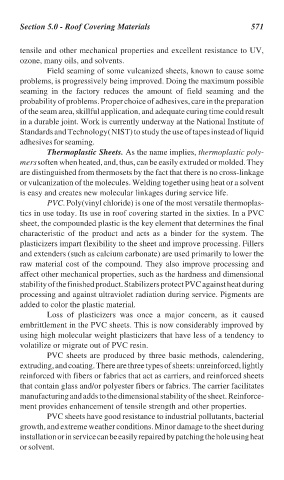Page 604 - Handbook of Thermal Analysis of Construction Materials
P. 604
Section 5.0 - Roof Covering Materials 571
tensile and other mechanical properties and excellent resistance to UV,
ozone, many oils, and solvents.
Field seaming of some vulcanized sheets, known to cause some
problems, is progressively being improved. Doing the maximum possible
seaming in the factory reduces the amount of field seaming and the
probability of problems. Proper choice of adhesives, care in the preparation
of the seam area, skillful application, and adequate curing time could result
in a durable joint. Work is currently underway at the National Institute of
Standards and Technology (NIST) to study the use of tapes instead of liquid
adhesives for seaming.
Thermoplastic Sheets. As the name implies, thermoplastic poly-
mers soften when heated, and, thus, can be easily extruded or molded. They
are distinguished from thermosets by the fact that there is no cross-linkage
or vulcanization of the molecules. Welding together using heat or a solvent
is easy and creates new molecular linkages during service life.
PVC. Poly(vinyl chloride) is one of the most versatile thermoplas-
tics in use today. Its use in roof covering started in the sixties. In a PVC
sheet, the compounded plastic is the key element that determines the final
characteristic of the product and acts as a binder for the system. The
plasticizers impart flexibility to the sheet and improve processing. Fillers
and extenders (such as calcium carbonate) are used primarily to lower the
raw material cost of the compound. They also improve processing and
affect other mechanical properties, such as the hardness and dimensional
stability of the finished product. Stabilizers protect PVC against heat during
processing and against ultraviolet radiation during service. Pigments are
added to color the plastic material.
Loss of plasticizers was once a major concern, as it caused
embrittlement in the PVC sheets. This is now considerably improved by
using high molecular weight plasticizers that have less of a tendency to
volatilize or migrate out of PVC resin.
PVC sheets are produced by three basic methods, calendering,
extruding, and coating. There are three types of sheets: unreinforced, lightly
reinforced with fibers or fabrics that act as carriers, and reinforced sheets
that contain glass and/or polyester fibers or fabrics. The carrier facilitates
manufacturing and adds to the dimensional stability of the sheet. Reinforce-
ment provides enhancement of tensile strength and other properties.
PVC sheets have good resistance to industrial pollutants, bacterial
growth, and extreme weather conditions. Minor damage to the sheet during
installation or in service can be easily repaired by patching the hole using heat
or solvent.

